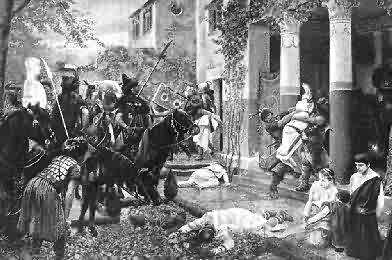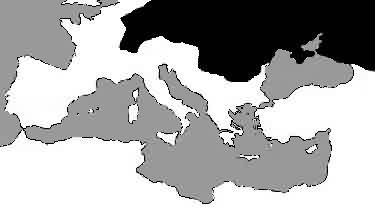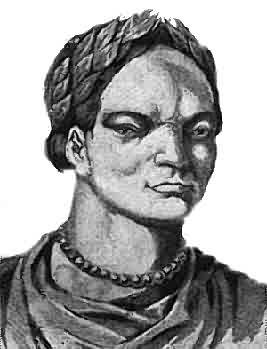
MARCH OF THE TITANS - A HISTORY OF THE WHITE RACE
CHAPTER 18 : THE FIRST GREAT RACE WAR - ATILLA THE HUN
To the eastern borders of the Roman Empire lay assorted Indo-European tribes, many still migrating from the north or even the ancient Nordic homeland between the Black and Caspian Seas.
Amongst all these Indo-European tribes one major group became known as the Goths, who, in the form of their various tribes, the Ostrogoths, the Visigoths and others - were to play a significant role in the final overrunning of the Western Roman Empire.
Initially however, Roman force of arms held them at bay beyond the eastern European continental borders of the Empire. The Goths and their racial cousins kept up a continuous localized war with the Romans for many years, and would have doubtless continued to do so for even longer had a new powerful racial foe not emerged which threatened to destroy the Goths, Germans, Romans and indeed all of Europe.
Into the midst of the struggles between the Germans, the Goths and Rome was to come the very first open race war in Europe - the invasion by Asiatics called the Huns.

The Nonwhite terror: Asiatics, known as Huns, attacked the easternmost White tribes, the Alans, in 372 AD. Quickly annihilating the Alans, they marched east forcing the squabbling Whites - Romans, Germans and Goths - in Europe to unite and face the communal racial threat. An overt race war, fought across Europe, then followed, with the Huns being defeated at Troyes in central France and at Nedao in Central Europe. White Europe was nearly extinguished by this threat - here is a depiction of a scene which befell hundreds of thousands of Whites - a raiding Nonwhite party attack a Roman villa, killing the males and carrying off the White women for sexual slavery.
ALANS - THE FIRST VICTIMS
Physically described by Romans as being "short, brown skinned and slant eyed" the Huns emerged from central Asia and burst upon the easternmost Whites, a tribe called the Alans, in 372 BC.
The Alans, a Nordic tribe still living in the ancestral homeland between the Black and Caspian seas, were crushed by the Huns who had developed cavalry fighting to a fine skill. Remnants of the Alans fled south and west - to this day there are traces of this last Nordic tribe to be found amongst the present day inhabitants of the region.
The Alans who fled westwards sought refuge with the Ostrogoths, bringing with them the first news of the new Asiatic terror.
OSTROGOTHS FALL BEFORE HUN INVASION
If the Ostrogoths wondered what had befallen the Alans, they did not have long to find out. Very soon the Huns swept even further west and invaded the Ostrogothic lands (in modern day western Russia) and defeated them as well.
The Ostrogothic king, Hermanric, committed suicide when the scale of the invasion became apparent, and his successor, Vitimer, was killed while trying to hold back the Huns.
The Ostrogothic kingdom in western Russia disintegrated, and its survivors streamed further westwards, into the lands of the Visigoths and Slavs.
VISIGOTHS BARGAIN WITH THE ROMANS
Athanairc, king of the Visigoths, engaged the Huns at the Dniester River in modern day Bulgaria, but the Huns defeated the Visigothic army as well. After this defeat, the Visigoths were forced to fall back and beg the Romans for permission to settle inside Roman territory.
This appeal was made all the more remarkable when it is borne in mind that the Romans and Visigoths had been at virtual constant war for near enough to two centuries. So when the Romans finally gave permission to the Visigoths to move into Roman territory, it was at a terrible price - the Visigoths had to surrender all their weapons and hand over large numbers of their women and children as hostages.
Crossing the Danube in 376 BC and settling in modern day Bulgaria, the Visigoths managed to gain a temporary reprieve from the ravages of the Huns. The conditions under which the Romans forced them to stay were such that it as not long before Visigothic resentment boiled over into open rebellion.
VISIGOTH REBELLION - BATTLE OF HADRIANOPLE
The Visigoths secretly re-armed themselves and launched a campaign against the Roman strongholds of Thrace and Macedonia in northern Greece. Finally, in the battle of Hadrianople (378 AD) in modern day Greece, a Visigothic army defeated a Roman army under the personal command of the Emperor Valen - who had been the one to impose the harsh conditions of refuge upon the Visigoths. Valen himself was killed in this battle.
The defeat was all the more ironic as a large number of the Roman army's soldiers were in fact Gothic mercenaries. The Eastern Roman Empire then accepted the presence of the Visigoths in central Europe, and lifted many of the restrictions placed upon them by Valen.
While the Goths and the Romans were grappling with one another, the former Visigothic lands were being seized by the Huns.
By the time of the Battle of Adrianople, the Huns had occupied most of Dacia, the land originally seized by the Visigoths from Romans (and which corresponds to the present day country of Rumania).
EUROPE ALMOST ENTIRELY INVADED
At this stage the racial balance of Europe could have swung decisively in favor of the Asiatic Mongolians - all the original White ancestral homelands had been either been destroyed or occupied by the Huns.
In addition to this, the Huns also physically occupied large parts of western Russia and portions of central and eastern Europe, including entire portions of modern central Germany, Hungary and Rumania, turning them overnight into mini Asiatic states.
Not content with these conquests, the Asiatic Huns began pushing further westwards, causing entire nations to be moved and destroying virtually everything in their path.
In this way the remnants of the Alans, and many other minor Nordic tribes were forced westwards, in turn displacing other already settled tribes. It was this displacement which led to further migrations of assorted Germanic tribes into Spain and even as far as North Africa.
By 432 AD, during the reign of Roman Emperor Theodosius I, the Huns had increased their power base and stranglehold on eastern and parts of central Europe to the point where they actually collected a large annual tribute from Rome.
(By this time Rome was totally dependent on "barbarian" or German and Gaulish mercenaries for its defense - the mostly mixed race population of Rome had long since lost any social cohesiveness and ability to provide recruits for the army).

Europe under the Nonwhite Huns: The dark area shows the extent of the Asiatic invasion. In addition to this, the Huns also launched attacks into France, Italy and into northern Greece.
ATILLA THE HUN - BRUTAL LEADER
In 433 AD, the Huns gained a new king, whose name would become a byword for the Asiatic terror - Atilla.
The new Asiatic king established his headquarters at the village of Buda on the Danube River in 445 AD (Buda was later to combine with another village on the other side of the river, Pest, to become Budapest, the modern capital of Hungary).

Atilla the Hun. Leader of an Asiatic terror which swept across White Europe with such fury and cruelty that his name has remained to this day a byword for tyranny. After a Roman depiction.
By this time the Hunnish empire stretched from the Caspian sea in the east right up to the North Sea. In all of the area the Huns carried out a vicious racial war of extermination against the Whites who militarily were to weak to resist. Countless White settlements were wiped out, with the women routinely being carried off into captivity.
In 452 AD, Atilla began moving west again, with the intention of seizing France and finishing off all of Europe.
HUNNISH BLOOD ENTERS EASTERN EUROPE
By this stage the Huns had started on a limited scale to physically integrate with sections of the peoples they had conquered. Traces of the Mongolian influence can still be seen amongst some peoples in eastern Europe (the so called "Slavic look" which in fact is not Slavic at all, but mixed Mongolian/Slavic.)
Possibly as a result of this limited integration process, the Huns managed to recruit some locals into their army, and units of various eastern European tribes found themselves in the Hunnish army which finally invaded France. They were dealt with extremely harshly by their distant racial cousins if captured. The vast majority of the Hunnish army were however Mongolian and under the ultimate leadership of the unquestionably militarily astute Atilla.
The Huns stood poised to push through to the Atlantic Ocean - Europe stood on the very brink of extermination.
THE BATTLE OF TROYES - WHITES UNITE TO DEFEAT THE ASIATICS
The threat of the Hunnish army finally forced the ever squabbling Romans and Visigoths into a united front. A Roman army, under the last of the Western Empire's properly Roman generals, Aetius, joined up with a Visigoth army under their king, Theodoric I, and together they met the Hunnish army in central France near the present day city of Troyes in 451 AD.
In a day long battle, both sides inflicted heavy casualties on the other, with the Visigoth king, Theodoric, being killed in the fighting. By nightfall the combined White army had gained the upper hand over the Asians.
Atilla was forced to retreat all the way across Europe as far as Hungary, exacting a terrible revenge in slaughter and looting from those White settlements unfortunate enough to be in his path of retreat.
ATILLA SLAUGHTERS WHITES IN NORTHERN ITALY - ORIGINS OF VENICE
Defeated in the west, Atilla made one last attempt to destroy the Whites. In 452 the Asians invaded northern Italy and razed the city of Aqueila to the ground massacring as many of the inhabitants as they could find (the survivors fled into the nearby marshes, there to later establish the city of Venice).
Suddenly in 453 AD, the 60 year old Atilla died - allegedly of a burst blood vessel incurred during his wedding night exertions following his marriage to a local German princess (how much of that story is true is open to question: what is fact is that he took a blond German girl, named Hildico, as his wife, following an example set by many of his Mongolian warriors, whose genetic footprint can be seen on some faces in eastern Europe and Russia to this day.)
THE BATTLE OF NEDAO - GERMANICS SAVE THE WHITE RACE FROM EXTINCTION
Atilla's death was the signal for a revolt of the people subjugated by the Huns. In 454 AD, the Goths, Slavs and others in Europe who had managed to survive the nearly 70 years of cruel Asiatic rule, rose up and at the battle of Nedao in that year, defeated the Huns in a straight fight between a Mongolian and a Germanic army. The victory was total and the Huns were finally destroyed.
The battle of Nedao became one of the most significant battles in White history, for without it Europe would most likely have been completely overrun by Asiatics before 500 AD.
The Germans, as victors over the Huns, became famous amongst their Indo-European racial cousins, with the Icelandic word for German to this day translating literally as "peoples' defender".
THE HUNS FLEE
Suffering total defeat at the hands of the Germans, the vast majority of the surviving Asiatic Huns then fled back into the Far East, to the sea of Azov in Russia - fearing the retribution by the Whites that would follow (a fear which was fully justified, as the enraged and victorious Whites mercilessly put to death any bands of Hun stragglers they found).
THE HUNNISH LEGACY
However, the Huns left two significant things behind them - firstly they gave their name to the area which had functioned as their headquarters during their racial war, Hungary.
Secondly, some admixture of Mongolian genes occurred amongst the Slavic tribes which had been under the Asiatic Hunnish occupation for nearly 80 years. This was however by no means complete and only ultimately affected a small, but significant, number of the Indo-European Slavs.
The Slavs then expanded eastward into the regions of Russia which had been overrun by the Huns on their way west. There they also mixed with scattered remnants of the partly Hunnish, partly Slavic peoples the Huns had left behind.
All these mixes contributed towards creating the distinctive Russian "Slavic look" visible to this day in a small percentage of the eastern European population in Russia and elsewhere.
The greatest effect of the Hunnish invasion of Europe was however the extinction of the source of the Indo-European tribes from their ancestral homeland between the Black and Caspian Seas. Never again would this territory produce another Indo-European Nordic tribe - the fountain of new Nordic blood was forever extinguished, one of the most significant acts of racial genocide ever seen.
For the next thousand years, the territory between the Black and Caspian seas, which had been the first and original breeding ground for the Indo-European Nordic tribes, became an invasion route for waves of Nonwhite hordes from Asia: first the Huns - then the Avars (who were destroyed by a Germanic tribe called the Franks) - the Turks (who were only finally driven from Europe mainland after the First World War in 1918) - Magyars (who occupied Hungary) and other Asiatics, some descendants of whom eventually became the Gypsies still found in Eastern Europe.
or back to
or
All material (c) copyright Ostara Publications, 1999.
Re-use for commercial purposes strictly forbidden.